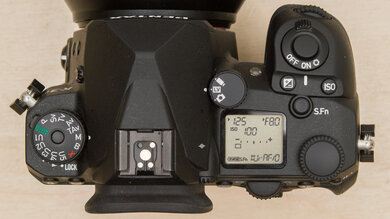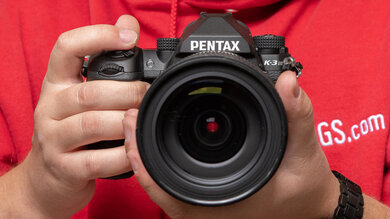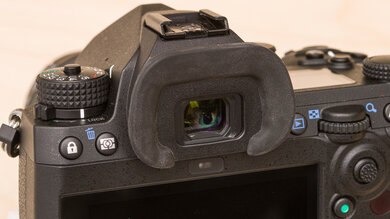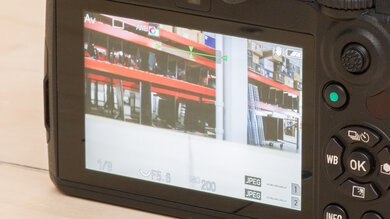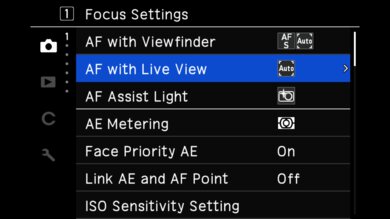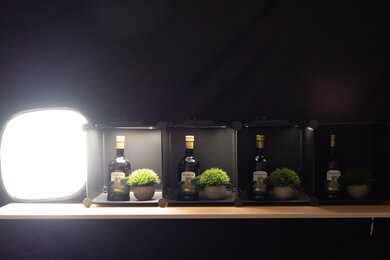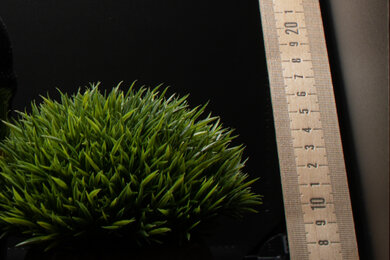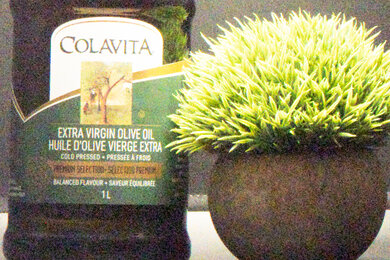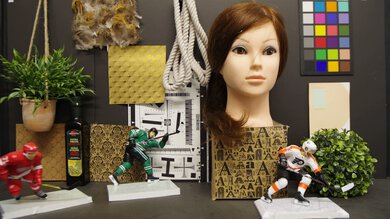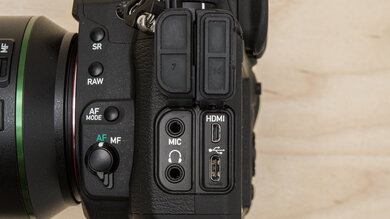The PENTAX K-3 Mark III is a premium APS-C DSLR camera. It's the most capable APS-C camera that the brand has released and the first to offer 4k video capability and a touchscreen. Its rugged all-weather design feels exceptionally sturdy, and the camera includes plenty of customization options. Despite the marketing gimmick of a 1,600,000 native ISO, its sensor does genuinely deliver when it comes to high-ISO performance and dynamic range. But even with these upgrades, the camera still feels like a bit of a relic in the era of mirrorless cameras, and with a price that far exceeds any comparable APS-C models, it's hard to justify unless you're dedicated to PENTAX's old-school approach to cameras.
Our Verdict
The PENTAX K3 III isn't especially good for travel because of its bulky size and weight. However, it's still an excellent photography camera if you don't mind traveling with a bulkier kit. It has an excellent battery life, which can last over multiple days depending on your usage habits, and it's one of the best in its class for high-ISO performance, which is great for getting clean shots in low light or at night. That said, its autofocus system lags behind many mirrorless competitors when it comes to tracking fast-moving subjects.
- Excellent image quality.
- Feels well-built and very comfortable to use.
- Excellent battery life for photos.
- Limited AF tracking capability.
- Heavy and bulky.
The PENTAX K3 Mark III is great for landscape photography, especially for an APS-C camera. Its sensor punches above its weight, with excellent dynamic range to capture a wider array of detail in high-contrast scenes and amazing high-ISO performance for low-light or nighttime landscapes. The camera's also incredibly sturdy, with a weather-sealed design that allows you to shoot in all kinds of weather conditions without worry. It just isn't the most portable camera, so it's less convenient to take on long hikes or remote shooting locations.
- Excellent image quality.
- Weather-sealed.
- Feels well-built and very comfortable to use.
- Heavy and bulky.
The PENTAX K3 III is okay for sport and wildlife photography. It can shoot at a quick max burst rate for sequential action shots, and the camera is incredibly well-built, meaning it can put up with heavy use in adverse shooting conditions. That said, it has a very limited buffer depth, and it takes a long time to empty its image buffer once full, meaning that if you prefer to shoot continuous bursts for action shots, you'll frequently experience long interruptions. The camera also lacks an automatic tracking feature in continuous shooting mode, though you can still get good results when using a single focus point and manually following a subject.
- Excellent image quality.
- Fast continuous shooting speed.
- Feels well-built and very comfortable to use.
- Limited AF tracking capability.
- Heavy and bulky.
- Limited buffer capacity with long clearing time.
The PENTAX K3 III isn't designed for vlogging. It has a fixed screen that doesn't let you monitor yourself while filming, and its heavy weight and large size make it impractical for walk-and-talk style vlogs.
- Feels well-built and very comfortable to use.
- Heavy and bulky.
- 4k frame rates and recording capability are limited.
- Fixed screen.
The PENTAX K3 III isn't well-suited to studio video. While it's the first Pentax camera with 4k video capability, it's still primarily a photography camera, and it shows. It can only record 4k videos in short clips and with a significant crop. Video quality isn't especially impressive either, and its contrast-detect autofocus system doesn't fare well with faster subjects.
- Feels well-built and very comfortable to use.
- Wide array of inputs and outputs.
- Heavy and bulky.
- 4k frame rates and recording capability are limited.
- Disappointing autofocus tracking in video.
The PENTAX K3 III isn't designed for action video. It's a hefty camera meant for handheld shooting rather than mounting, and beyond that, its autofocus struggles to effectively track moving subjects, so it's not the best choice for filming sports or action.
- Weather-sealed.
- Feels well-built and very comfortable to use.
- Heavy and bulky.
- 4k frame rates and recording capability are limited.
- Not waterproof.
- Disappointing autofocus tracking in video.
Changelog
- Updated May 17, 2023: Added text to 'Photo AF-C Tracking' and 'Photo AF-C Center Point' boxes and updated 'Photo RAW Noise' box.
- Updated Apr 24, 2023: Converted to Test Bench 0.12.
- Updated Apr 17, 2023: Converted to Test Bench 0.11.
- Updated Sep 23, 2022: Converted to Test Bench 0.10.
Check Price
Differences Between Sizes And Variants
The PENTAX K-3 Mark III comes in two color variants: 'Black' and 'Silver'. We tested the 'Black' model, and you can see our unit's label here.
You can buy the camera body on its own or bundle it with one of several available lens kit bundles, depending on the retailer.
Let us know if you come across another variant or if your PENTAX K-3 III doesn't correspond to our review, and we'll update it.
Popular Camera Comparisons
The third iteration of the PENTAX K-3 is a fantastic DSLR camera. It's ruggedly built, with plenty of thoughtful design features and customization options to give you more control over your shooting experience, and a powerful sensor that's sure to take beautiful photos in the right hands. However, it's also one of the most expensive APS-C cameras on the market, and in the age of mirrorless supremacy, it leaves a lot to be desired when it comes to shooting speed, autofocus, and video capability, making it doubtful if it's worth the price.
If you're looking for other DSLR options, check out our recommendations for the best DSLR cameras. Otherwise, you can explore mirrorless alternatives by checking out our list of best mirrorless cameras or see the best cameras we've tested for photography.
The Canon EOS 5D Mark IV and the PENTAX K-3 Mark III are both DSLR workhorses with sturdy builds and great ergonomics. Having said that, each has its own advantage over the other. The Canon uses a higher-resolution full-frame sensor, giving you more leeway to crop in images and when shooting in low light. The PENTAX, despite its smaller APS-C sensor, is a newer camera with newer tech, giving it a leg up when it comes to max burst rate and max ISO, though the Canon still has a larger photo buffer and a more reliable autofocus system.
The PENTAX K-3 Mark III and the Fujifilm X-T4 are both premium APS-C cameras, but they use different technologies with different advantages and disadvantages. The PENTAX is a DSLR, so it's heavier and bulkier, but it has an optical viewfinder and longer battery life. The Fujifilm, on the other hand, is a mirrorless camera, allowing for a much more portable body. It also performs significantly better when it comes to video features and autofocus tracking.
Test Results

The PENTAX K-3 III isn't especially portable, but it isn't bad for a DSLR. It is heavy, though, since it uses a pentaprism for its viewfinder, which adds a bit of weight. If you'd prefer a more portable camera, consider a mirrorless alternative like the Olympus OM-D E-M1 Mark III.
The camera feels very well-built. It has a sturdy magnesium alloy body with rubber-coated sides and thumb rest for better grip. The buttons and dials feel solid and offer good physical feedback. The inputs and outputs are covered by standard rubber flaps, while the battery compartment uses a secure locking hinged door.
The PENTAX K-3 Mark III uses the Pentax K-mount, which is compatible with K, KA, KAF, KAF2 (with power zoom), KAF3, or KAF4 lenses. The camera's weather-sealed and advertised to be dustproof as well as cold-resistant down to -10°C (14°F).
The camera has three command dials. By default in manual mode, the front dial near the shutter button controls shutter speed, the rear dial controls aperture, and the top dial (or 'E Dial') controls ISO. You can customize these and more (up to 10 buttons in total are customizable) to suit your preferences, and you can set different customizations for each shooting mode, which is great.
The camera feels incredibly comfortable to use. Its large handgrip fits the hand well, and it's suitable for all hand sizes to hold comfortably. The buttons and dials are well-spaced, making it easy to adjust settings with your eye to the viewfinder. It also has a top display, so you can quickly check settings and battery life at a glance.
The PENTAX K-3 Mark III uses a pentaprism in its viewfinder, which adds some weight to the camera but gives a clearer view through the viewfinder compared to a more inexpensive pentamirror mechanism. The eyecup around the viewfinder is very soft and comfortable.
The PENTAX K-3 III has a fixed screen, which is limiting for waist-level shooting or video work. The screen has a neat 'Night Vision' mode that decreases its luminosity and turns the display red for nighttime shooting.
The menu system and user interface is good. While settings are all pretty clearly labeled, the submenus are very long and could be more clearly organized. Thankfully, there's a quick menu function to easily access more common settings and a smart function ('S.Fn' button) menu that can be customized to access up to five different settings. If you don't understand what a setting does, the camera has an info/guide function to explain.
Battery life is great. The camera's 800-shot CIPA rating is better than most mirrorless models and is quite good for a DSLR, though it falls far short of some Nikon models like the Nikon D780. What that means is you're likely to get plenty out of this camera on a full charge, though that depends on how you use it.
It isn't quite as good for video, though it'll still last for about an hour and a half of continuous video recording. Just be aware that the battery can overheat when recording in 4k for longer periods.
The PENTAX K-3 III can shoot at a quick max burst rate of 11 fps, which is especially impressive relative to other DSLR cameras. It's more than fast enough for most shooting situations where you'd want to capture fast action like sports. That said, it has a very small photo buffer, even when shooting in JPEG, and on top of that, it takes a very long time for it to clear its buffer once full. That means even though you can shoot in quick bursts, you're going to quickly be interrupted, which isn't ideal when you're trying to capture fleeting moments.
The Pentax K-3 Mark III has a new and improved autofocus system, with 101 AF focus points, 41 of which are user-selectable, including 25 cross-type points for more precise focusing. There are also plenty of area modes and settings to tailor it to your preferences.
That includes an automatic face detection feature and a tracking setting in Live View mode that can track a moving subject when you half-press the shutter. However, once you press the shutter, the focus locks to that point. There's no continuous autofocus tracking available in Live View mode. Through the viewfinder, the camera supports AF-C, but no tracking feature is available. For that reason, we've set this test to N/A.
When using the center point, through the viewfinder, the camera's AF-C can keep up with moving subjects remarkably well. That's especially true if you use a lens with a relatively quick focusing motor.
The PENTAX K-3 Mark III features in-body image stabilization, and it does a fantastic job of stabilizing the sensor, so you can get clear handheld shots at very slow shutter speeds. We used the Pentax HD-DA 16-50mm f/2.8ED PLM AW lens, which doesn't have optical stabilization, but you can expect similar performance even with a kit lens and possibly even better performance with an optically stabilized lens.
The PENTAX K-3 Mark III has excellent dynamic range. It's right up there as far as APS-C cameras go and even surpasses a lot of older full-frame DSLRs. All in all, it can capture a wide range of highlight and shadow detail in high-contrast scenes. It also has really good exposure latitude, so you can make pretty significant exposure adjustments to your photos without introducing a whole lot of noise.
The PENTAX K-3 III takes very detailed photos. It does a good job of resolving fine detail, though this is mostly apparent when pixel-peeping.
The camera has excellent RAW noise handling, far better than most APS-C DSLR cameras we've tested. With shorter exposure times at high ISOs, noise is more visible, but RAW files are still relatively clean.
The PENTAX K-3 can only record 4k video with an additional 1.33x crop. It can't record 4k / 60 fps like the latest video-centric cameras can, but it records at up to 30 fps, which is great for standard and more cinematic video work. You just can't get smooth action footage or create slow-motion 4k video with these frame rates.
Internal recording isn't great in 4k, but that's not unusual, considering this camera's mainly aimed at photographers. It's capped to a seven-and-a-half-minute recording time, which doesn't give you a lot of time to record. Bit rates are also small, and it can only capture 8-bit 4:2:0 video internally, so it isn't capturing a great amount of information, resulting in lower overall video quality.
The PENTAX K-3 Mark III has a poor autofocus system when shooting 4k video. It's slow and unreliable, even when using a high-end lens like the DA 16-50mm f/2.8, which uses a PLM motor for autofocusing. While the motor is quiet, which is good for video work, it's still very slow to focus. The camera has face detection and does a good job of recognizing human subjects in the frame, but ultimately, it struggles to keep up with moving subjects.
Video quality is okay in 4k. It looks reasonably sharp and detailed, but because the camera can only record cropped 4k, it's using a smaller portion of the sensor, resulting in slightly worse quality than you might expect for 4k. In low light, video looks quite noisy and grainy, and the camera has trouble bringing out detail in the shadows.
The rolling shutter is passable. There's some noticeable skewing when panning the camera, but it isn't terrible and won't be too noticeable with slower camera movements.
In 1080p, the camera can record at up to 60 fps, which is great if you want to incorporate some light slow-motion footage into your videos or simply record smooth action video.
You can record a lot longer in 1080p than in 4k, though at 25 minutes, it falls a little bit short of the typical half-hour mark we see on most cameras. Bit rates are decent and about on par with other APS-C DSLRs, but in the age of mirrorless cameras with advanced video capability, it's a little underwhelming, though this camera is aimed mostly at photographers, so it isn't unexpected.
The autofocus doesn't perform very well in 1080p, either. It's especially bad at tracking faces. It frequently misses or loses its target, even if they're moving at a moderate pace. The general subject tracking is passable. It eventually finds its target, but it's still slow, having to play catch-up with moving subjects.
Thankfully, rolling shutter effect is better in 1080p. It's still present when the camera is moving very quickly, but you're much less likely to have distracting skewing or distortion in Full HD than you are in 4k.
The PENTAX K3 III has two SD card slots, though only one is rated for faster UHS-II cards. It's still a welcome addition, and given the camera's limited buffer, the advantage of a UHS-II card is marginal. There are three different storage settings when two SD cards are inserted, including sequential, which switches to the backup after the card in Slot 1 is full, duplicate, which uses the second card as a running backup, or an option to store RAW and JPEG photos separately on each card.
The camera comes equipped with plenty of inputs and outputs. It even has a cable release port, which is handy for long-exposure shots. It also has both a microphone and a headphone jack, as well as Micro HDMI and USB-C ports. All the ports are securely covered thanks to the camera's all-weather design.



